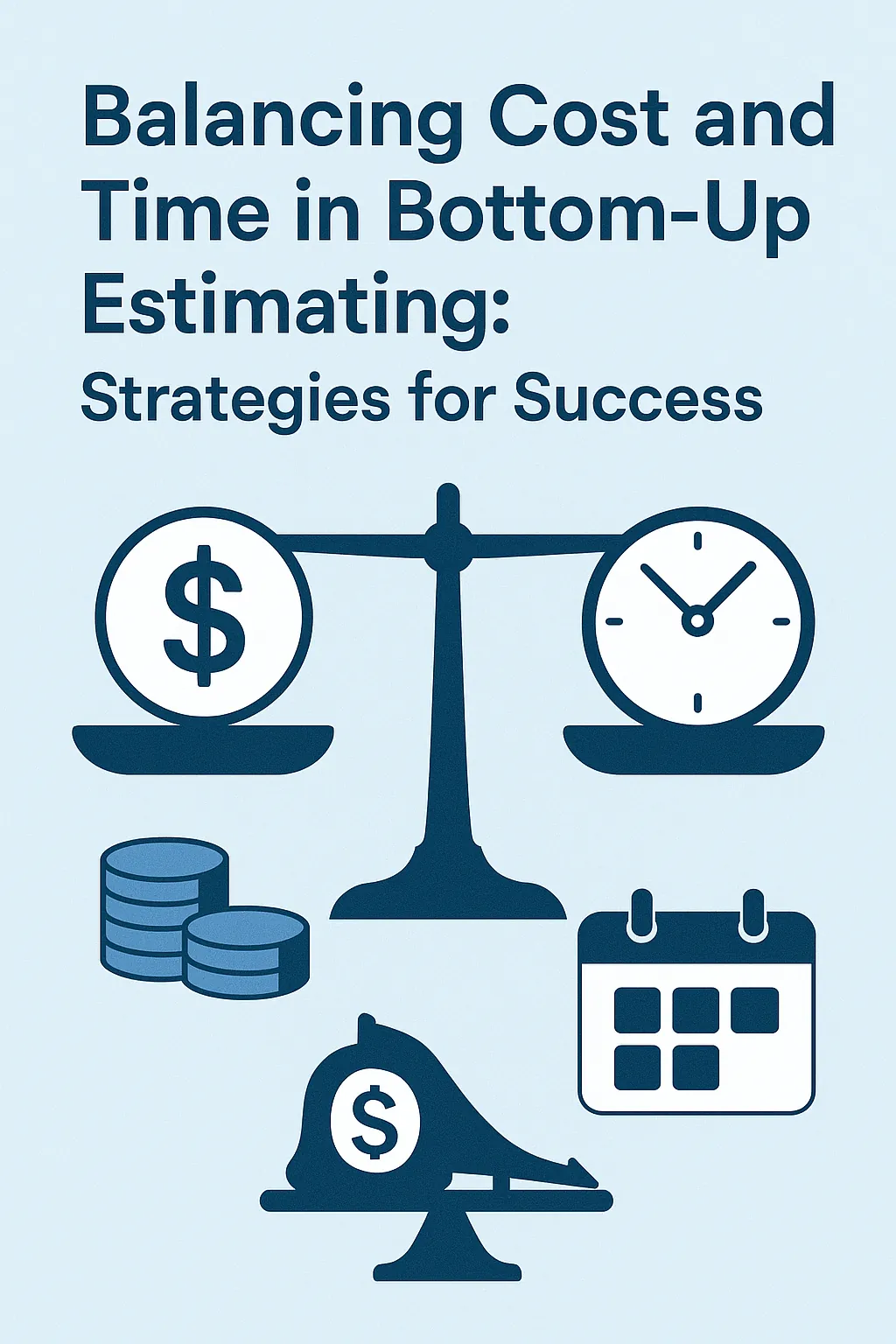Introduction to Bottom-Up Estimating
Bottom-up estimating is a project management technique that involves estimating the costs and durations of a project by breaking it down into its smallest components or tasks. This method starts from the granular level, where each individual task is assessed for its resource requirements, time, and costs, and then aggregates these estimates to form a comprehensive view of the entire project. This approach contrasts with top-down estimating, which relies on overall project goals and historical data to make broader estimates without detailed task analysis.
The role of bottom-up estimating in project planning and budgeting is crucial. By providing a detailed breakdown of tasks, it allows project managers to create more accurate and reliable estimates. This method not only helps in identifying the specific resources needed for each task but also aids in recognizing potential risks and challenges that may arise during project execution. As a result, it fosters better planning and resource allocation, which are essential for staying within budget and meeting deadlines.
Accurate cost and time estimates are vital for the success of any project. They serve as the foundation for project budgets and schedules, influencing decision-making and stakeholder expectations. When estimates are precise, project planners can effectively balance cost and time, ensuring that projects are completed on schedule and within financial constraints. Conversely, inaccurate estimates can lead to budget overruns, missed deadlines, and ultimately, project failure. Therefore, understanding and implementing bottom-up estimating is essential for project planners and financial analysts who aim to achieve successful project outcomes while managing the trade-offs between cost and schedule estimates.
Understanding Cost and Schedule Estimates
Effective planning hinges on accurate cost and schedule estimates. These estimates not only guide project execution but also help in balancing resources, timelines, and budgets. Below, we delve into the definitions of cost and schedule estimates, their components, and the intricate relationship between the two.
Definition of Cost Estimates and Their Components
Cost estimates refer to the anticipated expenses associated with a project, encompassing both direct and indirect costs. The primary components of cost estimates include:
- Direct Costs: These are expenses that can be directly attributed to project activities, such as labor, materials, and equipment. For instance, if a project requires specific tools or materials, the costs for these items are considered direct costs.
- Indirect Costs: These costs are not directly tied to a specific project activity but are necessary for overall project execution. Examples include administrative expenses, utilities, and overhead costs.
- Contingency Reserves: These are funds set aside to address unforeseen circumstances or risks that may arise during the project lifecycle. They are crucial for managing uncertainties and ensuring that the project remains on track financially.
- Resource Costs: This includes the costs associated with human resources, such as salaries, benefits, and training expenses for team members involved in the project.
Accurate cost estimation is vital as it minimizes uncertainty and helps project managers identify potential financial risks early in the planning process [5][6].
Definition of Schedule Estimates and Their Components
Schedule estimates involve predicting the time required to complete project tasks and deliverables. Key components of schedule estimates include:
- Task Duration: This refers to the estimated time needed to complete individual tasks or work packages. It is essential to break down the project into smaller components to assess the time required accurately.
- Dependencies: Understanding the relationships between tasks is crucial. Some tasks may depend on the completion of others, which can affect the overall timeline. Identifying these dependencies helps in creating a realistic schedule.
- Milestones: These are significant points in the project timeline that mark the completion of key phases or deliverables. Milestones help in tracking progress and ensuring that the project stays on schedule.
- Resource Availability: The availability of team members and equipment can impact task durations. Schedule estimates must consider when resources will be available to avoid delays.
Effective schedule estimation is essential for maintaining project timelines and ensuring that deliverables are met as planned [2][12].
Discussion on the Relationship Between Cost and Time Estimates in Project Management
The relationship between cost and time estimates is a critical aspect of project management. These two elements are often interdependent, and changes in one can significantly impact the other:
- Trade-offs: In many cases, project managers face trade-offs between cost and time. For instance, if a project is behind schedule, managers may need to allocate additional resources, which can increase costs. Conversely, reducing costs by cutting resources may lead to extended timelines.
- Risk Management: Understanding the interplay between cost and time estimates allows project managers to identify potential risks. For example, if a project is estimated to take longer than expected, it may require additional funding to cover extended labor costs.
- Stakeholder Expectations: Balancing cost and schedule estimates is crucial for meeting stakeholder expectations. Clear communication about how changes in one area may affect the other can help manage stakeholder concerns and ensure alignment on project goals.
- Performance Measurement: Regularly comparing actual costs and timelines against estimates helps in assessing project performance. This analysis can inform future projects and improve estimation accuracy over time [4][9].
The Trade-Offs Between Cost and Time
In the context of bottom-up estimating, understanding the trade-offs between cost and time is crucial for effective planning and execution. This section delves into the concept of cost-time trade-offs, providing insights and real-world examples that illustrate how prioritizing one aspect can significantly impact the other.
Understanding the Cost-Time Trade-Off Concept
The cost-time trade-off refers to the relationship between the expenses incurred in a project and the time required to complete it. In essence, it highlights the balancing act project managers must perform when making decisions about resource allocation. When a project manager opts to expedite a project, it often leads to increased costs due to the need for additional resources or overtime labor. Conversely, if a project is allowed to extend over a longer period, it may result in lower immediate costs but could lead to increased overhead and potential delays in revenue generation.
- Bottom-Up Estimating: This technique involves estimating costs and durations at the most granular level of the work breakdown structure (WBS). By aggregating these detailed estimates, project managers can develop a comprehensive view of the project’s financial and temporal requirements. However, this method also necessitates careful consideration of the trade-offs involved, as more accurate estimates can require more time and resources to compile [5][12].
Examples of Prioritizing Cost or Time
- Prioritizing Time: In a scenario where a company is launching a new product, the project manager may decide to accelerate the timeline to capture market share quickly. This decision could involve hiring additional staff or paying for expedited shipping of materials, leading to a significant increase in costs. While this approach may yield immediate benefits, it can also strain the budget and affect the project’s overall profitability [10][11].
- Prioritizing Cost: Conversely, if a project manager chooses to minimize costs by extending the project timeline, they may opt for less expensive materials or resources. While this can lead to savings, it may also result in delays that could jeopardize the project’s success, especially if competitors are moving faster in the market. The trade-off here is clear: lower costs can lead to longer timelines, which may ultimately affect the project’s competitive edge [4][14].
Real-World Scenarios Illustrating Trade-Offs
- Construction Projects: In construction, a project manager might face a decision between using high-quality materials that ensure durability (higher cost) versus cheaper alternatives that may require more frequent repairs (lower cost). If the project is on a tight schedule, opting for the cheaper materials could save time initially but may lead to higher long-term costs due to maintenance and repairs [3][9].
- Software Development: In software projects, teams often encounter the dilemma of delivering a product quickly versus ensuring comprehensive testing. A decision to prioritize speed may lead to a rushed release, resulting in bugs and customer dissatisfaction, which can ultimately increase costs due to the need for patches and updates. On the other hand, taking the time to thoroughly test the software can enhance quality but may delay the launch and increase development costs [2][8].
Strategies for Effective Bottom-Up Estimating
Bottom-up estimating is a crucial technique in project management that allows for detailed and accurate predictions of project costs and timelines. However, balancing these estimates can be challenging. Here are some actionable strategies to help project planners and financial analysts achieve this balance effectively:
- Involving the Right Stakeholders in the Estimating Process: Engaging team members who will be executing the tasks is essential. Their insights can provide a more realistic view of the time and resources required. By including diverse perspectives from various stakeholders, you can ensure that all aspects of the project are considered, leading to more accurate estimates. This collaborative approach not only enhances the quality of the estimates but also fosters a sense of ownership among team members, which can improve project execution [1][2].
- Utilizing Historical Data and Expert Judgment: Leveraging historical data from previous projects can significantly enhance the accuracy of your estimates. Analyzing past performance metrics allows you to identify trends and potential pitfalls. Additionally, consulting with experts who have experience in similar projects can provide valuable insights that may not be immediately apparent. This combination of data-driven analysis and expert opinion can help refine your estimates and mitigate risks associated with cost and time overruns [3][4].
- Adopting a Phased Approach to Refining Estimates: Implementing a phased approach allows for continuous refinement of estimates as the project progresses. Start with broad estimates and gradually break down the project into smaller components, refining the estimates at each phase. This iterative process helps in adjusting for any changes in scope or unforeseen challenges, ensuring that both cost and time estimates remain aligned with project realities [5][6].
- Implementing Tools and Software for More Accurate Estimations: Utilizing project management tools and software can streamline the estimating process. These tools often come equipped with features that allow for real-time tracking of resources, time, and costs, which can enhance the accuracy of your estimates. Additionally, many software solutions offer templates and historical data integration, making it easier to apply past learnings to current projects. By adopting these technologies, project managers can reduce the likelihood of errors and improve overall project efficiency [7][8].
By employing these strategies, project planners and financial analysts can effectively balance cost and time estimates in bottom-up estimating, leading to more successful project outcomes.
Best Practices in Balancing Cost and Schedule
When employing bottom-up estimating techniques, balancing cost and schedule is crucial for project success. Here are some best practices that project planners and financial analysts can adopt to effectively manage these trade-offs:
- Establish a Solid Project Scope: Clearly defining the project scope at the outset is essential to avoid scope creep, which can lead to increased costs and extended timelines. A well-defined scope helps in accurately estimating the resources, time, and costs required for each task, ensuring that all team members are aligned on project objectives and deliverables [1][10].
- Regularly Review and Update Estimates: Throughout the project lifecycle, it is important to continuously review and update estimates. As the project progresses, new information may emerge that can affect both cost and schedule. By regularly revisiting estimates, project managers can make informed adjustments that reflect the current state of the project, thereby enhancing accuracy and reducing the risk of overruns [4][12].
- Communicate Openly About Potential Trade-offs: Effective communication with stakeholders regarding potential trade-offs between cost and schedule is vital. Project planners should engage in discussions that highlight the implications of prioritizing one aspect over the other. For instance, expediting a project may lead to increased costs, while cutting costs may extend the timeline. Transparent communication fosters trust and allows stakeholders to make informed decisions [3][11].
- Document Lessons Learned for Future Projects: After project completion, documenting lessons learned is a valuable practice that can inform future projects. By analyzing what worked well and what did not in terms of balancing cost and schedule, project planners can refine their estimating techniques and strategies. This continuous improvement process enhances the overall effectiveness of project management practices [2][9].
By implementing these best practices, project planners and financial analysts can better navigate the complexities of bottom-up estimating, leading to more successful project outcomes that align with both budgetary and scheduling goals.
Conclusion and Key Takeaways
Bottom-up estimating stands out as a vital technique that enhances the accuracy of project cost and time predictions. By breaking down projects into smaller, manageable components, this method allows project planners and financial analysts to assess each task’s requirements in detail. This granular approach not only leads to more precise estimates but also fosters a deeper understanding of the project’s overall scope and resource needs [1][10][12].
- Significance of Bottom-Up Estimating: The importance of bottom-up estimating cannot be overstated. It provides a comprehensive view of the project, enabling teams to identify potential challenges and resource constraints early in the planning process. This proactive approach helps mitigate risks associated with cost overruns and missed deadlines, ultimately contributing to the project’s success [3][11][13]. Moreover, the accuracy of bottom-up estimates, which typically ranges between -5% and +10%, makes it a preferred choice for complex projects where precision is critical [11].
- Trade-offs Between Cost and Schedule: As project planners navigate the intricacies of bottom-up estimating, they must also consider the inherent trade-offs between cost and schedule. While a detailed estimation process can lead to more accurate forecasts, it often requires significant time and resources for data collection and analysis [14]. This labor-intensive nature of bottom-up estimating may lead to longer planning phases, which can impact the overall project timeline. Therefore, it is essential to strike a balance between the depth of analysis and the urgency of project delivery. Understanding these trade-offs allows teams to make informed decisions that align with project goals and stakeholder expectations [2][14].
- Encouragement to Implement Strategies: To achieve improved project outcomes, it is crucial for project planners and financial analysts to implement the strategies discussed throughout this blog. By embracing the bottom-up estimating approach, teams can enhance their forecasting capabilities, leading to better resource allocation and more effective project management. Encouraging collaboration among team members during the estimation process can also yield valuable insights and foster a sense of ownership over project deliverables [2][6][15]. Ultimately, the successful integration of bottom-up estimating into project planning will not only balance cost and time but also pave the way for successful project execution and stakeholder satisfaction.
Find out more about Shaun Stoltz https://www.shaunstoltz.com/about/.
This post was written by an AI and reviewed/edited by a human.



